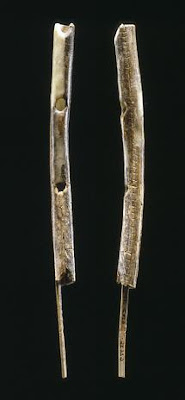Lo strumento musicale più antico del mondo ha 43 mila anni. Uno studio pubbllicato su Journal of Human Evolution.
 Nella grotta di Geißenklösterle, nel sud della Germania, ricercatori delle università di Oxford e Tübingen hanno scoperto quello che viene considerato il più antico strumento musicale: un flauto di osso di Mammuth.
Nella grotta di Geißenklösterle, nel sud della Germania, ricercatori delle università di Oxford e Tübingen hanno scoperto quello che viene considerato il più antico strumento musicale: un flauto di osso di Mammuth.Nella grotta di Geißenklösterle sono stati trovati ornamenti realizzati con ossa e denti di animali (Credits: Universitaet Tübingen).
Per determinare la nuova datazione, compresa fra 42 e 43 mila anni fa è stato utilizzato un nuovo metodo di riduzione delle contaminazioni dei reperti prima di effettuare la radiodatazione.
Lo studio, pubblicato sulla rivista Journal of Human Evolution l'8 maggio 2012 porta la firma di Thomas Higham, Laura Basell, Roger Jacobi, Rachel Wood, Christopher Bronk Ramsey, Nicholas J. Conard.
Τesting models for the beginnings of the Aurignacian and the advent of figurative art and music: The radiocarbon chronology of Geißenklösterle.
Abstract
The German site of Geißenklösterle is crucial to debates concerning the European Middle to Upper Palaeolithic transition and the origins of the Aurignacian in Europe. Previous dates from the site are central to an important hypothesis, the Kulturpumpe model, which posits that the Swabian Jura was an area where crucial behavioural developments took place and then spread to other parts of Europe.
 The previous chronology (critical to the model), is based mainly on radiocarbon dating, but remains poorly constrained due to the dating resolution and the variability of dates. The cause of these problems is disputed, but two principal explanations have been proposed: a) larger than expected variations in the production of atmospheric radiocarbon, and b) taphonomic influences in the site mixing the bones that were dated into different parts of the site. We reinvestigate the chronology using a new series of radiocarbon determinations obtained from the Mousterian, Aurignacian and Gravettian levels. The results strongly imply that the previous dates were affected by insufficient decontamination of the bone collagen prior to dating. Using an ultrafiltration protocol the chronometric picture becomes much clearer. Comparison of the results against other recently dated sites in other parts of Europe suggests the Early Aurignacian levels are earlier than other sites in the south of France and Italy, but not as early as recently dated sites which suggest a pre-Aurignacian dispersal of modern humans to Italy by ∼45000 cal BP. They are consistent with the importance of the Danube Corridor as a key route for the movement of people and ideas. The new dates fail to refute the Kulturpumpe model and suggest that Swabian Jura is a region that contributed significantly to the evolution of symbolic behaviour as indicated by early evidence for figurative art, music and mythical imagery.
The previous chronology (critical to the model), is based mainly on radiocarbon dating, but remains poorly constrained due to the dating resolution and the variability of dates. The cause of these problems is disputed, but two principal explanations have been proposed: a) larger than expected variations in the production of atmospheric radiocarbon, and b) taphonomic influences in the site mixing the bones that were dated into different parts of the site. We reinvestigate the chronology using a new series of radiocarbon determinations obtained from the Mousterian, Aurignacian and Gravettian levels. The results strongly imply that the previous dates were affected by insufficient decontamination of the bone collagen prior to dating. Using an ultrafiltration protocol the chronometric picture becomes much clearer. Comparison of the results against other recently dated sites in other parts of Europe suggests the Early Aurignacian levels are earlier than other sites in the south of France and Italy, but not as early as recently dated sites which suggest a pre-Aurignacian dispersal of modern humans to Italy by ∼45000 cal BP. They are consistent with the importance of the Danube Corridor as a key route for the movement of people and ideas. The new dates fail to refute the Kulturpumpe model and suggest that Swabian Jura is a region that contributed significantly to the evolution of symbolic behaviour as indicated by early evidence for figurative art, music and mythical imagery.


Commenti